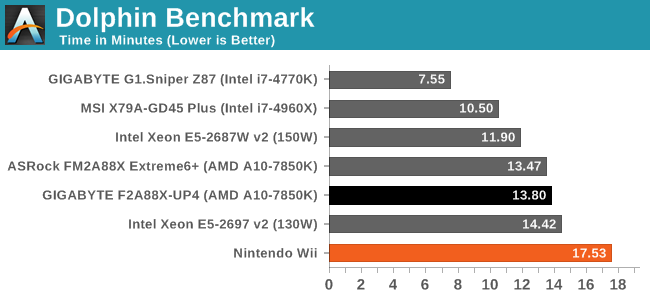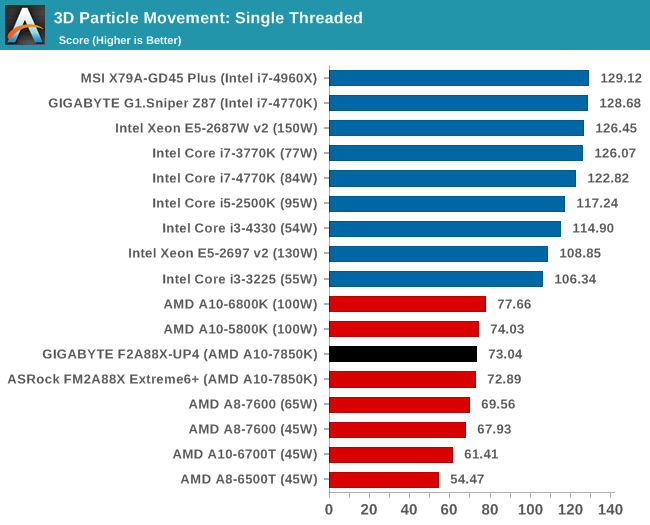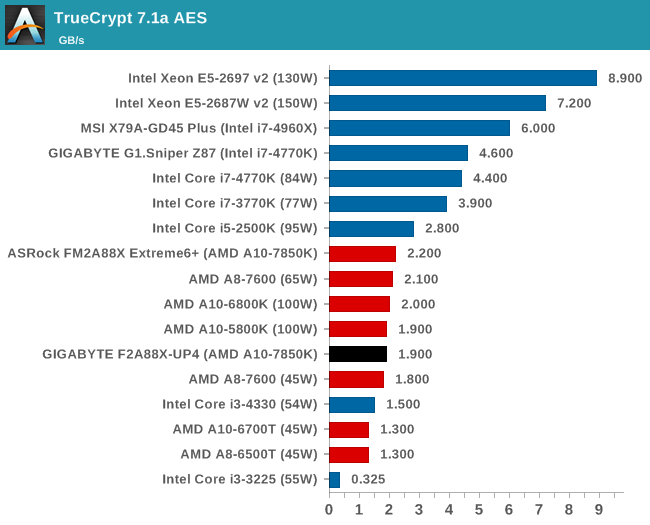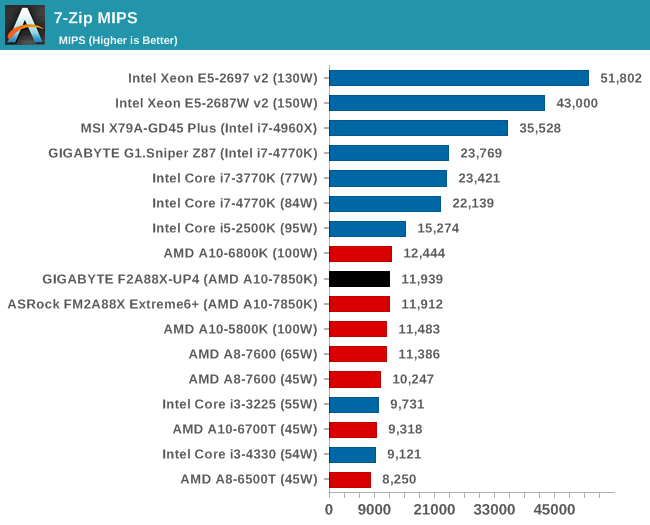GIGABYTE F2A88X-UP4 Review
by Ian Cutress on March 24, 2014 11:59 AM EST- Posted in
- Motherboards
- AMD
- Gigabyte
- FM2
Scientific and Synthetic Benchmarks
2D to 3D Rendering –Agisoft PhotoScan v1.0: link
Agisoft Photoscan creates 3D models from 2D images, a process which is very computationally expensive. The algorithm is split into four distinct phases, and different phases of the model reconstruction require either fast memory, fast IPC, more cores, or even OpenCL compute devices to hand. Agisoft supplied us with a special version of the software to script the process, where we take 50 images of a stately home and convert it into a medium quality model. This benchmark typically takes around 15-20 minutes on a high end PC on the CPU alone, with GPUs reducing the time.

Console Emulation –Dolphin Benchmark: link
At the start of 2014 I was emailed with a link to a new emulation benchmark based on the Dolphin Emulator. The issue with emulators tends to be two-fold: game licensing and raw CPU power required for the emulation. As a result, many emulators are often bound by single thread CPU performance, and general reports tended to suggest that Haswell provided a significant boost to emulator performance. This benchmark runs a Wii program that raytraces a complex 3D scene inside the Dolphin Wii emulator. Performance on this benchmark is a good proxy of the speed of Dolphin CPU emulation, which is an intensive single core task using most aspects of a CPU. Results are given in minutes, where the Wii itself scores 17.53; meaning that anything above this is faster than an actual Wii for processing Wii code, albeit emulated.

Point Calculations – 3D Movement Algorithm Test: link
3DPM is a self-penned benchmark, taking basic 3D movement algorithms used in Brownian Motion simulations and testing them for speed. High floating point performance, MHz and IPC wins in the single thread version, whereas the multithread version has to handle the threads and loves more cores.


Encryption –TrueCrypt v0.7.1a: link
TrueCrypt is an off the shelf open source encryption tool for files and folders. For our test we run the benchmark mode using a 1GB buffer and take the mean result from AES encryption.

TrueCrypt had a significant defecit to the Extreme6+, suggesting that the Turbo mode on the UP4 during this benchmark was not engaging properly.
Synthetic – 7-Zip 9.2: link
As an open source compression tool, 7-Zip is a popular tool for making sets of files easier to handle and transfer. The software offers up its own benchmark, to which we report the result.











18 Comments
View All Comments
PrimarchLion - Monday, March 24, 2014 - link
Nice catch. Hope they fix it (It's on the Teat Setup page).Ryan Smith - Tuesday, March 25, 2014 - link
Thanks. It has been corrected.ricster7227@gmail.com - Wednesday, March 26, 2014 - link
Ian,I am finnding many of the same shortfalls in my build as you have mentioned. I did have a big hastle in the loading a fresh copy of Win 7 into my machine however I am using an older A5800K APU. I was lucky that the board came with the updated Bios but even then it was unstable. It has been a challenge. All said and done iot is working pretty well and is OC'd to 4.3 Mghz. Next step is to get the Kaveri and a graphics card for Adobe works.
frozenland - Wednesday, March 26, 2014 - link
Why do they keep making ATX boards with FM2+ socket? What is the point in researching boards with this much potential for additional graphics power when the CPU that is intended to be used here has GPU built-in? Why can't they spend more money into researching better AM3+ FX platforms where the CPU performance can be better than the top-of-line 7850K and better potential for graphics?APU in my opinion is for small form factors, and if you really want discrete graphics card, why bother with A series at all? FX + discrete card (or intel) makes more sense.
ricster7227@gmail.com - Thursday, March 27, 2014 - link
If you follow the logic of the overall effort that AMD is taking for website and Adobe type creation you will find that additional high powerred graphics cards will be added to make this all possible. Presently you can spend a good $ 30,000 for an Intel - Nvidia Solution and use it for a year only to start over again by your standards. Life is not all gaming or mining.Dirk Broer - Saturday, March 29, 2014 - link
I am using FM1 and FM2 ATX motherboards with great satisfaction as a cruncher. I prefer ATX above small form factors due to the greater flexibility in amout of memory and number of GPUs.warrenstraw222 - Monday, April 14, 2014 - link
Swiss watch brand Alpina <strong><a href="http://werachaiyodvilai.yolasite.com/">Rep... Watches</a></strong> continues development of its watches with the arrival at the end of the yearvic_neoh - Wednesday, April 30, 2014 - link
I purchased this motherboard and the AMD A-10-7850 CPU. This board meets my expectations and needs except in one area. It only provides one 10 pin audio connector on the board. If it is used for the case audio connections it is not available for my 5.25" usb/sata/eta/audio/power media front panel device. I have found not solution short of devising my own dual audio connection cable.